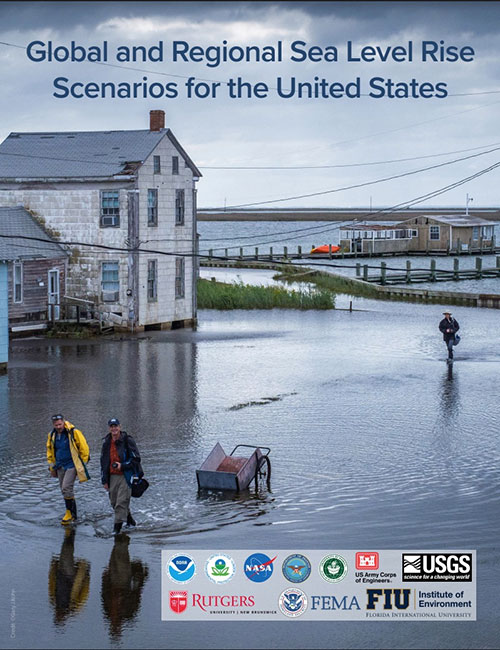There are two types of uncertainty that are important to consider when
thinking about future sea level changes: 1) uncertainty in representing or
modeling the physical processes that cause sea level change known as process uncertainty, and
2) uncertainty in how human behavior will
drive future emissions and ensuing warming known as emissions uncertainty. The suite of
projections in this report captures both process uncertainty and emissions
uncertainty.
Process uncertainty
is associated with how well we currently understand why sea level has
changed in the past and how it will change in the future at specific times
and locations. To capture process uncertainty in sea level rise
projections, there is a range of uncertainty around each individual
scenario (i.e., the low/17th%, median/50% and high/83rd% values for each
particular scenario). The farther forward in time we move, the greater the
uncertainty around each projection.
Emissions uncertainty is captured in the range between the five global mean sea level rise
scenarios: Low (1 foot; 0.3 meters), Intermediate Low (1.6 feet; 0.5 meters), Intermediate (3.3 feet;
1.0 meter), Intermediate High (4.9 feet; 1.5 meters), and High (6.6 feet; 2.0 meters). In other words,
the range between the five sea level scenarios is closely connected to emissions uncertainty, while
the range around a given scenario is associated with process uncertainty.
In addition to process and emissions uncertainty, there is still scientific discussion and
investigation underway on the potential for rapid ice sheet melt and collapse, sometimes referred to
as low confidence processes. Currently there is no scientific consensus on whether rapid melt will occur
and, if it does, what that process will look like. Given that it is possible, those processes are
included in international and federal assessments. The possibility of rapid ice sheet melt is a
significant driver in reaching the highest scenarios in the 2022 technical report.
We know that throughout time, global sea levels have changed by tens to hundreds of meters over
approximately 100,000-year cycles. And that in arriving at the stages of sea level equilibriums (the
dips and humps of global sea levels through time), there is evidence of periods of rapid rise on the
order of meters of rise over 100-year periods. Due to the “committed sea level rise” from continued
warming of the ocean, over the course of the next several centuries the higher scenarios might be
approached as “when, not if” if warming and emissions continue to rise unchecked. Or, put another way,
there is uncertainty in how quickly the “dynamics” associated with ice sheets may affect future sea
level rise, but not regarding whether or not global sea levels in the next several centuries will
rise by at least a few meters.
See Section 2.2.2 and Box 2.1 of the
technical report for more information on uncertainty in sea-level rise.
 An official website of the United States government.
An official website of the United States government.








